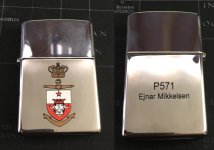- Reaction score
- 1,027
- Points
- 1,160
Underway said:A manually sighted 76mm?? Whaaaa? That just seems like such a waste for a beautiful dual purpose gun. Your photos were very revealing. Those 76's seem to only hold their ready use ammo, as it didn't seem like there was a magazine elevator. Short and sharp engagements only, with limited reload ability, like the MCDV 40's were.
As for crewing Chief Stoker you know better then most here that the RCN won't do anything with such a small crew given the missions and required watches. That would force the CO to stand a bridge watch like those dirty Coast Guard Captains, the Watch Officers to stand 1 in 3 for eight hour watches and everything on the ship to be super automated.
Yes there was a ammo loading hatch in the deck and was told there was a ammo lifting cruet. Its not a quick evolution. It was interesting to note that while the ships were fitted for a containerized weapon system, that space was used for racks of spare parts. As for crewing, sadly I would think you're correct. Interesting to note AOPS will be highly automated.





